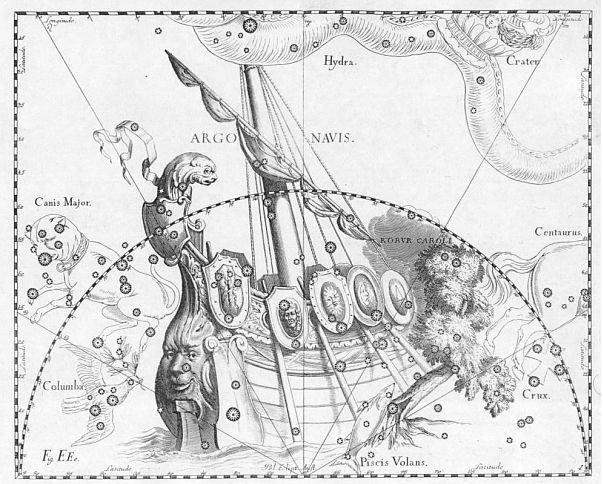|

(Drawn by Johannes
Hevelius)
According to a variety of sources of the legend, the Argo was said to
have been planned or constructed with the help of Athena. According to other
legends it contained in its prow a magical piece of timber from the sacred
forest of Dodona, which could speak and render prophecies.
Argo Navis is the only one of the 48 constellations listed by the 2nd
century astronomer Ptolemy that is no longer officially recognised as a
constellation. It was unwieldy due to its enormous size: were it still
considered a single constellation, it would be the largest of all. In
1752, the French astronomer Nicolas Louis de Lacaille subdivided it into
Carina (the keel, or the hull, of the ship), Puppis (the poop deck), and
Vela (the sails). When Argo Navis was split, its Bayer designations were
also split. Carina has the α, β and ε, Vela has γ and δ,
Puppis has ζ,
and so on.
The constellation Pyxis (the mariner's compass) occupies an
area which in antiquity was considered part of Argo's mast (called
Malus). However, Pyxis is not now considered part of Argo Navis, and its
Bayer designations are separate from those of Carina, Puppis and
Vela.
(Wikipedia)
|
When
reading the universal sign language of ancient man the first and
obvious rule is to react to what is unusual. Here we have an example in form of the only odd constellation of 48 which did not
survive up to modern times. It must have been banned, I guess, and
maybe for
some reason similar to why Ophiuchus did not survive
- although this constellation disappeared totally as described
earlier at Roto Iri Are (crf the excursion at hoea).
The
enormous size of ancient Argo Navis associates to how the whole of Easter
Island may have been likened to a great ship. Its
prow (which disappeared under the water) was a piece of magical
timber from the sacred forest of Dodona, but the picture
above suggests it was also the 'Tree':
"Robur
Carolinum, Charles' Oak, the Quercia of Italy and
the Karlseiche of Germany, was formally published by Halley
in 1679 in commemoration of the Royal Oak of his patron, Charles II,
in which the king had lain hidden for twenty-four hours after his
defeat by Cromwell in the battle of Worcester, on the 3rd of
September 1651." (Allen)
Myths
form history. Was the king really hidden in an oak for 24 hours?
Probably myth transformed the story, so that half 48 became the
duration of the hidden (absent) king - i.e. corresponding to the
degrees of latitute for the tropic of Capricorn.
Argo Navis was drawn by the tail of Canis Major
- cfr at toki - and this was presumably because the harbour had been
reached:
... Sternforward
Argō by the Great Dog's tail // Is drawn; for hers is not
a usual course, // But backward turned she comes, as vessels do //
When sailors have transposed the crooked stern // On entering
harbour; all the ship reverse, // And gliding backward on the beach
it grounds. // Sternforward thus is Jason's Argō drawn ...
Also in the rongorongo idiom
a sign of reversal means the journey
has ended:
Hevelius has above drawn the images of Sun and Moon in the
center (close to the mast respectively adjoining Sun at
right). Sun has stopped (he is drawn
en face) and his 'Tree' has toppled.
|

